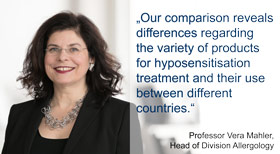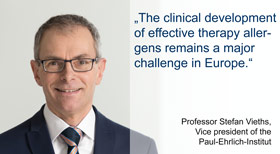Differences in immune therapies of allergies between the USA and Europe
Allergen immunotherapy (AIT) is an established treatment option which differs significantly between the USA and Europe. The differences not only concern the spectrum of products available for AIT but also their clinical development, diagnostic procedures, and regulatory affairs by the competent authorities. In a review article published in the Journal of Allergy and Clinical Immunology, Experts of the Paul-Ehrlich-Institut (PEI), in co-operation with colleagues from Berlin and the USA, present important differences and provide an overview of the current state of AIT.
AIT, also known as desensitisation or hyposensitisation was first developed for the treatment of hay-fever more than 100 years ago. AIT involves a type of therapy – usually over a period of several years – which helps the immune system to "get used to" the allergen so that the allergy is alleviated on a sustained basis or at best even removed. While regulatory framework conditions as well as the medicines available are similar in the USA to those in Europe in many areas, major differences exist between the two countries in the field of immunotherapy. Professor Vera Mahler, head of the Allergology Division of the Paul-Ehrlich-Institut (PEI), and Professor Stefan Vieths, vice president of the PEI and up to early 2017 head of the Allergology Division, as well as colleagues from the Allergy Asthma Center Westend, Berlin, the Lenoir-Rhyne University, Hickory, USA, and the Cincinnati College of Medicine, have highlighted important differences regarding therapeutic allergen products, diagnostic methods, the clinical management of the treatment, and regulatory framework conditions. The complexity and diversity of the situation are also shown in the fact that the presentation of the results required five tables and four figures.
Major differences exist at the levels of the product diversity and the type of use: in North America, standardised and non-standardised aqueous inhalation allergen extracts (e.g. from grass pollen) authorised by the US Food and Drug Administration (FDA) are available for treatment. Unlike in Europe, these products are almost exclusively used subcutaneously (injected into the adipose tissue beneath the skin) (SCIT, subcutaneous immunotherapy). In Europe, additional products are available such as aluminium and tyrosine-absorbed allergens and chemically modified allergens with reduced allergen potential (allergoids). Furthermore, allergens in Europe are not only administered subcutaneously. A type of sublingual treatment (SLIT) involving placement of the allergen under the tongue is available with aqueous formulations or tables. This therapy accounts for a major share of the market.

Another major difference is that in the USA, extracts from various types of pollen, mould spores, domestic dust mites, or animal hair allergens are often mixed and injected at the doctor's office. In Europe, mixtures of varying sources of allergens are not used as a rule, because of their dilution effect. Here, allergists will prefer injections of single highly dosed allergens or homologous groups of allergens if these allergens are considered as clinically relevant. Such allergens include those which lead to clinical symptoms of allergy in the patient or could be life-threatening.

Regulatory framework conditions and statistical procedures also differ between the two countries. While the Food and Drug Administration (FDA) has defined the minimum clinical effect by means of a statistical process, the European Commission requires a statistically significant difference in selected primary endpoints (defined target criteria of a clinical study). In addition, in Europe, the clinical significance of the effect found in a clinical trial must be presented for the individual patient.
"Treatment of allergies is complex – starting with the great variety of allergens which partly have different seasonal effects, via the route of administration of therapeutic allergens right down to the evaluation of clinical data. Our comparison reveals differences regarding the variety of products for hyposensitisation treatment and their use between different countries"
, explained Professor Vera Mahler. The PEI is the only regulatory institute in Europe that has created a division specialised in allergology in a timely manner to ensure quality, efficacy, and safety of therapy allergens. It was the driving force for implementing the Therapy Allergen Ordinance (Therapieallergene-Verordnung, TAV) which has been in effect in Germany since 2008. "The clinical development of effective therapy allergens remains a major challenge in Europe. Our experts at the PEI are making important contributions to the further development of therapy allergens through their scientific commitment and co-operation in developing international guidelines,"
explained Professor Stefan Vieths.
Original publication
Mahler V, Esch RE, Kleine-Tebbe J, Lavery WJ, Plunkett G, Vieths S, Bernstein DI (2019): Understanding Differences in Allergen Immunotherapy Products and Practices in North America and Europe.
J Allergy Clin Immunol 143: 813-828.
Text
Contact:
Paul-Ehrlich-Institut
Press Office
Telefon: +49 6103 77 1030
Email: presse@pei.de
top




